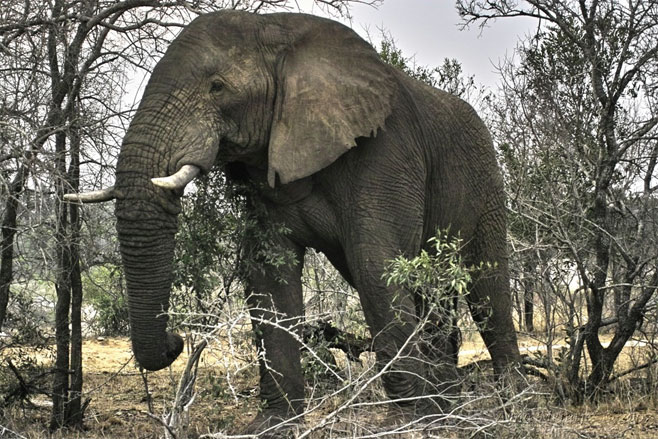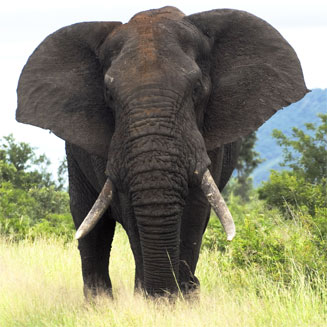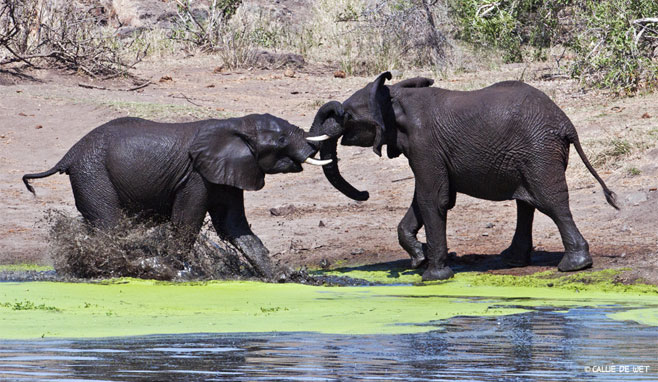|
Loxodonta africana
(African elephant)
elephant [English]; olifant, Afrika-olifant [Afrikaans]; Afrikanischer Elefant [German]; eléphant d' Afrique [French];
ndovu, tembo [Swahili];
indlovu ye-Afrika [isiNdebele];
indlovu [isiXhosa] [isiZulu] [siSwati]; dou [Sepedi] [Sesotho] [Sctswana];
nzou, zhou
[Shona]; ndlopfu [Xitsonga]; ndou [Tshivenda];
tou
[Lozi] unjovo [Yei]; ╪ Khoab [Nama] [Damara]; ndhlovu, ndjou [Herero]
Life
>
Eukaryotes >
Opisthokonta >
Metazoa (animals) > Bilateria > Deuterostomia >
Chordata > Craniata > Vertebrata (vertebrates) >
Gnathostomata (jawed vertebrates) > Teleostomi (teleost
fish) > Osteichthyes (bony fish) > Class:
Sarcopterygii (lobe-finned fish) > Stegocephalia
(terrestrial vertebrates) > Reptiliomorpha > Amniota >
Synapsida (mammal-like reptiles) > Therapsida > Theriodontia
> Cynodontia > Mammalia (mammals)
> Placentalia (placental mammals) >
Afrotheria > Paenungulata > Tethytheria >
Proboscidea
(elephants, mammoths)
 |
|
African elephant, Kruger National Park, South
Africa. [photo Arno Meintjes
©] |
 |
 |
|
African elephant, Kruger National Park, South
Africa. [photo Arno Meintjes
©] |
White desert form of the African elephant, Etosha
National Park, Namibia. [photo
Coke Smith
©] |
 |
|
Two young elephants playfully fighting, Sweni
River, Kruger National Park, South Africa. [photo
Callie de Wet ©] |
 |
|
A herd of elephants at Chobe National Park,
Botswana. [photo
Coke Smith
©] |
Identification
African elephants are the largest living land mammals. As elephants grow
continuously throughout their lives, the largest member of a herd is usually the
oldest. The largest known specimen was killed in Angola in 1955. Weighing 10 000
kg and 4 m high at the shoulder, it is now on display at the Smithsonian
institution in Washington D. C. At birth the African elephant weighs 120 kg.
Elephants are easily recognized by their massive size,
their long truck and large ears and most carry tusks although some individuals
and populations are tuskless. The heaviest pair of tusks recorded, came from
Kenya and weighed 102.3 kg and 97 kg respectively. The elephant’s skull is
massive in order to support the tusks and comprises up to 25% of its body
weight.
Size
Male: Body Length 1.5 m; height at shoulder 3.2 – 4.0
m; weight range 5 000 - 6 300 kg.
Female: Body Length 1.5 m; height at shoulder 2.5 – 3.4 m; weight range 2 800 –
3 500 kg.
Dentition
The single upper incisor grows into the tusks and the
molars fall out at the front of the upper and lower jaw when worn down. They are
replaced by the next tooth from behind. Only one tooth on each side, above and
below is in use at any one time. At the age of 60 only the last molar (M6)
remains and maybe only a fragment of the original tooth. At this stage the
elephant is unable to chew its food properly and begins to decline physically,
essentially it starves.
Dental formula:
I C C P P M M
Distribution and habitat
Occurs in Africa south of the Sahara, preferring savanna grassland and forest. They tolerate a wide
range of habitats providing sufficient food, water and shade are available.
General behaviour
Elephants live in small family groups led by an older cow
the matriarch. At times of abundant food or water several family groups may
congregate to form a large herd. Adult bulls are solitary or from part of
smaller bachelor groups and only join the family herds when females are in
breeding condition.
Food
An adult elephant may eat up to 300 kg of plant
material a day. The diet consists of a variety of plants, including trees,
fruit, shrubs and grass.
Gestation
22 months
Life span
60 years in the wild, 80 years in captivity.
Importance
The elephant is one of Africa’s “Big Five”.
Conservation
The most serious threats to elephants include the
poaching for ivory and the encroachment by humans and agriculture on their
traditional ranges and migration routes. In protected areas where large herds
survive but cannot range widely they can inflict huge damage on vegetation.
Limiting elephant populations causes huge debate and culling while the most
economical option in many instances is unacceptable to many people as a
solution.
Text by Denise Hamerton
|
